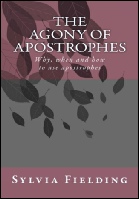



But what about the most common mistake of all? Many of us are confused about whether to use “its” or “it’s”. Again, there is a very simple rule that will ensure you never get it wrong again. Here’s the rule:
The only time you should put an apostrophe in “its” is when it is short for “it is” or “it has” or when you mean “it is” or “it has”. When being used in a possessive sense eg, “The dog has lost its bone”, this never takes an apostrophe. If an apostrophe is inserted, the sentence is then saying, “The dog has lost it is (or it has) bone”, which is clearly wrong.
Test yourself on the use of “it’s” vs “its”
The apostrophe is also used to indicate that a letter or letters (usually vowels, but not always) are missing from a word and where two words have been contracted into one word eg, “haven’t” (have not), “isn’t” (is not), “you’ll” (you will), or where a single word has been contracted eg, “So’ton” meaning “Southampton”. Where a word has simply been abbreviated eg, “ad”, “pub”, “demo”, it does not require an apostrophe and to insert one would be incorrect.
Please feel free to email me with your apostrophe queries. I will reply as soon as possible and use them to improve this resource.
Email your apostrophe queries
Click here for apostrophe FAQs
Many of us have problems with apostrophes, but once you know the simple rules you’ll never have trouble with them again.
The apostrophe is mainly used to indicate possession. In the following phrases, the apostrophes have been deliberately omitted. To determine where the apostrophe should go, the question to ask yourself is: “Whom or what does the ‘so-and-so’ belong to or refer to?”
- The childs toys
- The students books (read as several students)
- The peoples community centre
- The chickens eggs (read as one chicken)
- The childrens Christmas party
So, the questions to ask are:
- Whom do the toys belong to? The answer is the ‘child’ - therefore the apostrophe goes immediately after the word ‘child’ before the ‘s’. The correct statement should read: The child’s toys.
- Whom do the books belong to? The answer is the ‘students’ - therefore the apostrophe goes immediately after the word ‘students’, after the ‘s’. The correct statement should read: The students’ books.
- Whom does the community centre belong to? The answer is the ‘people’ - therefore the apostrophe goes immediately after the word ‘people’ before the ‘s’. The correct statement should read: The people’s community centre.
- Whom do the eggs belong to? The answer is the ‘chicken’ - therefore the apostrophe goes immediately after the word ‘chicken’ before the ‘s’. The correct statement is: The chicken’s eggs.
- Whom does the Christmas party belong to or refer to? The answer is the ‘children’ - therefore the apostrophe goes immediately after the word ‘children’ before the ‘s’. The correct statement should read: The children’s Christmas Party.
The apostrophe goes immediately after whatever word is the answer to the question “Whom or what does the ‘so-and-so’ belong to or refer to? If the word in your answer to that question does not have an ‘s’ at the end, then the apostrophe goes before the ‘s’.
As you will see from the following phrases, it’s important to insert the apostrophe in the correct place because wrongly placed it can completely change the meaning.
- These are my brothers (these people are my brothers)
- These are my brother’s (these things belong to my brother)
- These are my brothers’ (these things belong to my brothers)

My new paperback version of “The Agony of Apostrophes”, which is based on all the queries received via my website, is now available on Amazon for just £3.95.
Read more about the book here…

Check out my Poems section on the website to see many examples of the correct usage of the apostrophe - I hope you enjoy the poems too.
| Email Apostrophe Query |
| Test yourself on it's and its |
| Apostrophe Quiz |
| Web Check |
| Writing |
| Document Quality Check |
| Proofreading and Copyediting |
| Web Check Request |